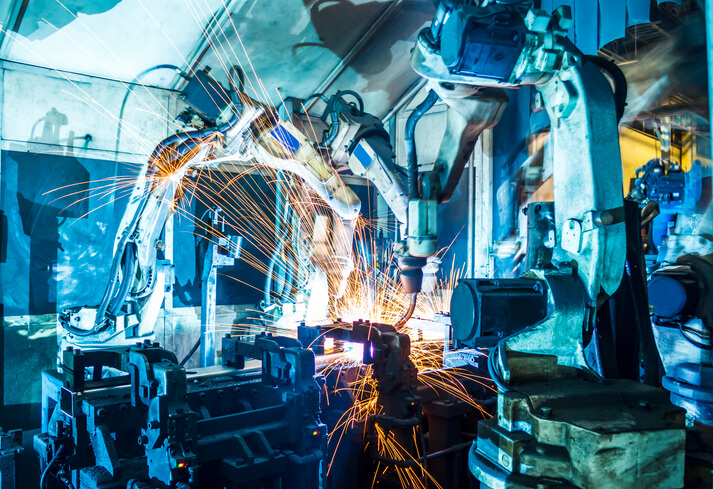Technology and robotics are advancing at a rapid pace in every industry, and welding is no different. Applying automation, advanced technology, and robotics to welding applications has increased performance, speed, precision, and quality while minimizing errors and inconsistencies in welding processes.
Automated robotics in welding have had great success in increasing production and minimizing errors. However, robots also assist in manual welding by performing the welding process itself while being controlled and supervised by a professional welder.
C.R. Metal Products has both robotic and manual welding capabilities to meet all of your welding needs. Contact our team to get started.
Welding Automation
Automated welding is the process of joining metals using robotics. These specialized welding robots are computer-based and can be programmed to complete specific jobs. With sensors that allow the robot to follow the seam and apply correct welding parameters, these robots help increase the performance, speed, precision, and quality of the weld. Robots also increase the safety of welding jobs since welders will no longer be inhaling harmful fumes by being so close to the metal.
Partial Automation
Partial automation splits the work between a professional welder using manual techniques and an automated robot. This process is great for particularly complex or specialized welding techniques because it combines the experience of an expert welder with the precision of an industrial welding machine.
Partially automated welding increases productivity and improves weld quality. Automated, computer-based robots control weld heat better than a human welder can, which causes less distortion in the weld itself. It is also able to reproduce and repeat tasks more frequently and with more accuracy than a human welder. Not to mention, it improves working conditions for welders since they don’t have to be at the torch inhaling fumes.
Total Automation
Total automation is when every welding function and process is performed by an automated robot without any adjustment by a professional welder. These total, or full, automation welding machines are programmed by computers to complete the welding process from start to finish.
Fully automated machines are able to perform many of the welding techniques used today. From single resistance spot welding to complicated welding processes, these machines are able to coordinate to complete the job while dealing with large 3D objects.
Using fully automated welding practices can increase production because these machines are able to run all day, every day while providing consistent results. However, for some particularly complex projects, having a professional expert welder is beneficial.
Types of Welding Robots
Each welding job is different, and while welding robots are able to complete many jobs, certain machines have different applications. Let’s explore the different robots for welding needs.
Robotic Gas Metal Arc Welding (GMAW/MIG)
Robotic Gas Metal Arc Welding, or Robotic Metal Inert Gas Welding, is one of the most popular forms of welding and is easy to integrate into a robotic process. During this process, a wire is continuously fed toward the heated weld tip and acts as the filler material, creating the bond. This is a high deposition rate process, meaning there is more material added to the weld during this technique.
MIG robots are semi-automatic, or partially automated, requiring a professional welder to control and monitor the machine. These robots are able to weld stainless steel, copper, nickel, carbon, steel, aluminum, or any other metal with a high melting point. They are capable of all positions which adds flexibility to the welding process.
Robotic Gas Tungsten Arc Welding (GTAW/TIG)
Robotic Gas Tungsten Arc Welding, or Tungsten Inert Gas Welding, is used to weld thin parts together and for aesthetic and precise welds.
These robots are equipped with cameras to help with joint locations, tracking, and error detection. After the operator calibrates the camera and teaches the robot the weld path, the computer automatically controls torch movement, shielding gas pre-flow, arc length, and pulse frequency as it follows the weld path. Welders are still required for these robots, as they are responsible for feeding the filler rod into the molten puddle. These robots are also able to soft start and stop the heat, which makes TIG different from other welding techniques.
Robotic Laser Welding
Robotic laser welding uses a focused laser beam as an energy source for melting and joining metals. This process is great for welding materials of different thicknesses from different angles and directions.
These machines are composed of a fiber laser head, a tracking system, and industrial robotic machinery. The highly focused beam provides precise control over the weld penetration and heat input, resulting in a clean and consistent weld bead, making this welding technique a top choice for the medical and aerospace industries.
Cut Costs and Maximize Production Speed with CR Metal Products’ Robotic Welding Services
Our state-of-the-art robotics, including MIG and TIG welding robots, and laser welding services ensures that we deliver the highest quality metal products for you each and every time. With decades of experience, our robotic and manual welders are certified under the ASME, AWS Codes, and Caterpillar 1E0099S specifications.
For any of your welding needs, CR Metal Products is here to help. Contact us today to get started!
